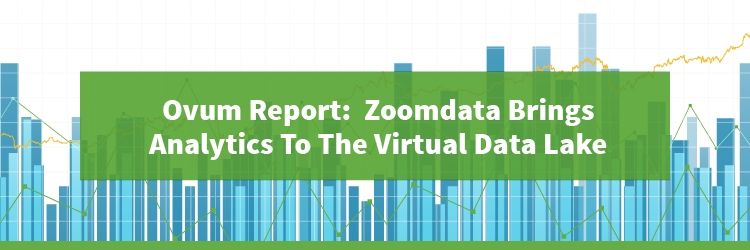We can credit James Dixon, the founder and CTO of Pentaho, for coming up with the term data lake. That was in 2011 or thereabouts. And, as use of data lakes has grown, there’s been plenty written about them.
What’s new under the sun right now with data lakes is the idea of the virtual data lake. Ovum, in its 2018 Trends to Watch report, recognized that the data lake is no longer just a huge Hadoop repository — or any single data store. Today’s enterprise data lake is a collection of data sources, which may be different for every organization. The question then becomes how do you allow end users without technical knowledge access to the data in the virtual lake?
As stated in the Ovum report, Zoomdata picks up, “where the Tableaus of the world leave off.” The reality of the data lake (virtual or physical) is that the same old approaches that served BI so well in the past, just won’t work. Zoomdata excels where others fail by pushing query processing as close to the data as possible.
This vital distinction sets Zoomdata apart. Where traditional BI tries to speed up query time by taking ownership of the data, Zoomdata focuses on new approaches such as Data Sharpening™ that gives users the low latency required for data exploration.
At Zoomdata, we recognize that the data landscape constantly changes. We see data in traditional data warehouses, data lakes, data rivers (streaming data), and on good old user desktops. We believe in a data-driven world where users are free to ask questions, explore, and share insights about data whether it’s in the data center, in the cloud or both. We see the virtual data lake as the norm -- a natural expression of the nature of data in the modern world where data is constantly generated, refined, and repurposed.
Democratizing Big Data Analytics
Ovum believes that Zoomdata’s long-standing mission to democratize big data analytics beyond data scientists — analytics for the 99 percent, not just the one percent — is well served by the current platform and its product roadmap.
The firm emphasizes three key points in its overview of Zoomdata. Zoomdata focuses on:
- Enabling business users to analyze heterogeneous data, wherever it resides and without moving or modeling the data first
- Optimizing the processing of data through use of Spark and pushdown processing
- Using Data Sharpening™ to cushion users from the frustrations of data latencies when querying data lakes
Ovum rightly points out that data latencies are apt to be more likely with virtual data lakes than with traditional data warehouses or data marts. And the rate at which new data are added to data lakes (physical or virtual) is only increasing.
New use cases for data generate new initiatives to collect more data and fill in information gaps. Business challenges evolve and become digital, creating new data pipelines. And, disruptions such IoT drive the collection of more data than businesses know what to do with.
In these conditions, organizations must take an agile approach to data management. The virtual data lake is an outcome of that agile approach, which requires modern technology to harness its power for an organization by allowing the 99 percent of data users to explore, interact, combine, understand and share data. Zoomdata accelerates data democratization and enables the modern data-driven enterprise.
To learn more about what Ovum has to say, you can download a complimentary copy of its research note: “Zoomdata brings analytics to the virtual data lake.”
